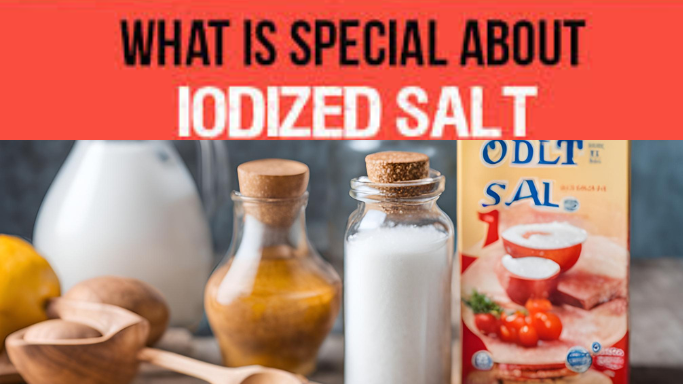Iodized salt is a type of table salt that has been fortified with iodine, a trace element that is vital for the proper functioning of the thyroid gland. Iodine plays a crucial role in hormone production, which regulates metabolism, growth, and development. Iodized salt was introduced as a public health measure in the early 20th century to address widespread iodine deficiencies, which were causing serious health issues like goiter and cretinism. But in today’s world, with improved access to iodine-rich foods and supplements, many people wonder: Do we still need iodized salt?
The Importance of Iodine in the Diet
Iodine is essential for the production of thyroid hormones, which regulate various bodily functions, including metabolism, energy production, and the development of the brain and nervous system. A deficiency in iodine can lead to hypothyroidism, which can cause symptoms like weight gain, fatigue, and cognitive impairments. In severe cases, it can lead to goiter (an enlarged thyroid gland), and during pregnancy, iodine deficiency can result in birth defects or developmental delays in babies.
Historically, iodine deficiency was widespread, especially in areas far from the sea, where iodine-rich foods like fish and seaweed were scarce. To combat this, iodized salt was introduced as a simple, cost-effective solution that could ensure populations received enough iodine in their diets. By adding iodine to salt, a food product already consumed daily, it became possible to reach a wide population with a nutrient that was otherwise difficult to obtain.
How Is Iodized Salt Made?
Iodized salt is made by adding a small amount of iodine, usually in the form of potassium iodide, to table salt during the production process. Table salt is refined and often treated with anti-caking agents to keep it from clumping, which makes it a suitable carrier for iodine. The level of iodine in iodized salt is regulated to ensure that it provides an adequate amount of iodine without being excessive. The amount added is very small, typically around 45 micrograms of iodine per gram of salt, which is enough to meet the daily needs of most people.
Do You Need Iodized Salt?
In most developed countries, iodine deficiency is rare today, thanks to the widespread availability of iodized salt. However, some populations, especially in areas where people rely on non-iodized salt or do not consume many iodine-rich foods, may still be at risk for iodine deficiency. This is particularly important for pregnant women, whose iodine needs increase during pregnancy, and for children whose development can be affected by insufficient iodine intake.
Despite the availability of iodized salt, some people choose to avoid it for various reasons. For instance, some prefer sea salt or Himalayan pink salt, both of which are often sold as “natural” alternatives to refined table salt. While these salts contain trace minerals that may provide a slightly different flavor profile, they are generally not fortified with iodine. If your diet does not include many iodine-rich foods (such as dairy, fish, or eggs), using iodized salt may be beneficial to ensure adequate iodine intake.
Alternatives to Iodized Salt
If you prefer to avoid iodized salt, it’s still important to make sure you’re getting enough iodine from other sources. Here are some iodine-rich foods you can incorporate into your diet:
Seaweed (nori, kelp, wakame)
Fish (salmon, tuna, cod)
Dairy products (milk, yogurt, cheese)
Eggs (particularly the yolks)
Iodized supplements (if recommended by a healthcare provider)
For people living in regions where iodine-rich foods are not easily accessible, or for those with specific dietary restrictions, iodine supplementation may be necessary. Always consult with a healthcare provider before making changes to your salt or iodine intake.
Should You Use Iodized Salt?
Whether or not you need to use iodized salt depends on your individual dietary needs and preferences. For most people who consume a varied diet that includes dairy, fish, or fortified foods, iodine deficiency is unlikely. However, iodized salt remains a reliable and inexpensive way to ensure sufficient iodine intake. It’s especially important for pregnant women and those who may not consume enough iodine-rich foods.
If you are using non-iodized salts like sea salt or Himalayan pink salt, it’s essential to be mindful of other sources of iodine in your diet. If you’re unsure about your iodine needs, a healthcare professional can help determine whether you should incorporate iodized salt or an iodine supplement into your diet.
Conclusion
Iodized salt played a crucial role in eradicating iodine deficiency in the 20th century and continues to be an effective way to ensure adequate iodine intake for many people. While iodine deficiency is less common today, those who avoid iodized salt or consume limited iodine-rich foods may still be at risk. For most individuals, using iodized salt is an easy and effective way to meet iodine needs, but those who prefer alternatives should make sure they’re getting iodine from other sources. The decision to use iodized salt ultimately depends on your dietary preferences, health conditions, and individual needs.




